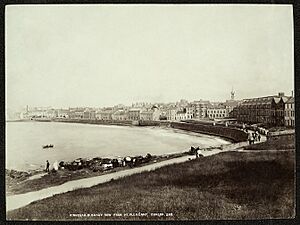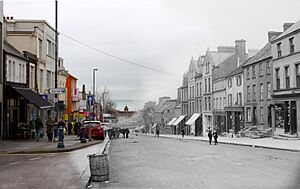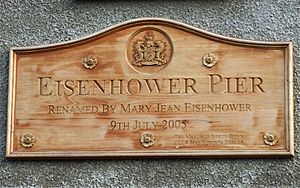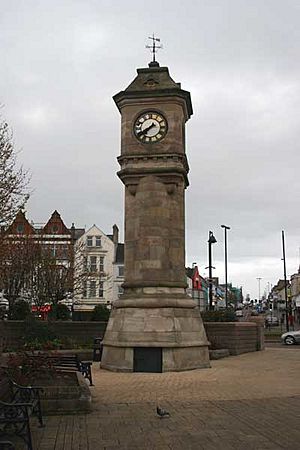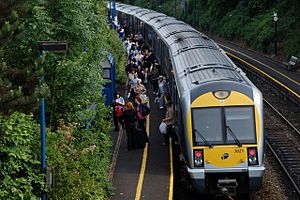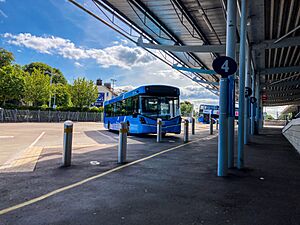Bangor, County Down facts for kids
Quick facts for kids Bangor
|
|
|---|---|
| City | |
 View of Bangor at night, from the Long Hole |
|
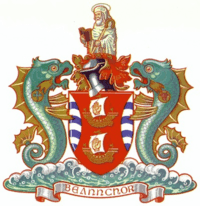 Coat of Arms of Bangor |
|
| Population | 64,596 (2021 census) |
| • Belfast | 13 mi (21 km) |
| District |
|
| County | |
| Country | Northern Ireland |
| Sovereign state | United Kingdom |
| Post town | BANGOR |
| Postcode district | BT19, BT20 |
| Dialling code | 028 |
| Police | Northern Ireland |
| Fire | Northern Ireland |
| Ambulance | Northern Ireland |
| EU Parliament | Northern Ireland |
| UK Parliament |
|
| NI Assembly |
|
Bangor is a city in County Down, Northern Ireland. It sits on the southern side of Belfast Lough, which is a large sea inlet. Bangor is part of the Belfast metropolitan area and is about 13 miles (22 km) east of Belfast city centre. You can travel between the two cities by road or train.
In 2021, Bangor had a population of 64,596 people. In 2022, Bangor was officially given "city status," making it Northern Ireland's sixth city.
Long ago, Bangor Abbey was a very important monastery founded in the 6th century by Saint Comgall. Bangor grew a lot in the 1600s when many Scottish settlers came to live there. Today, tourism is a big part of Bangor's economy, especially in the summer. The Bangor Marina is one of the largest in Ireland and has a special "Blue Flag" award for its cleanliness and facilities. Bangor is also home to the Royal Ulster and Ballyholme yacht clubs.
Contents
Name of Bangor
The name Bangor comes from an old Irish word, Beannchar. This word probably means 'place of points' or 'horned curve'. It might describe the shape of the shoreline around Bangor Bay.
Long ago, Bangor Bay was called Inber Beg, which means 'the little inlet'. This name came from a stream that used to flow past the abbey. Some people also called the area 'The Vale of Angels'. This is because Saint Patrick is said to have rested there and seen angels.
History of Bangor
Bangor has a very long and interesting history. People lived here as far back as the Bronze Age. Viking burials have also been found on Ballyholme beach. In the Victorian era, people from Belfast would travel to Bangor by train to enjoy the fresh sea air.
Bangor was once home to a famous Gaelic Irish monastery. This monastery was known across Europe for its learning. However, it also suffered from violent Viking raids in the 8th and 9th centuries. Later, during the Plantation of Ulster, many Scottish and English settlers made Bangor their new home.
Bangor Abbey
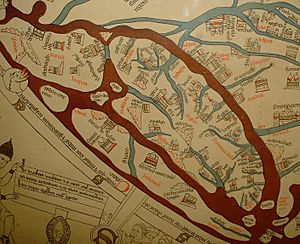
The monastery of Bangor was founded by Saint Comgall in the year 555 or 558. It was a place where important books were written, like the Antiphonary of Bangor. You can see a copy of this book in Bangor's heritage centre today.
The monastery was so important that it was one of only four places in Ireland shown on the Hereford Mappa Mundi, a famous world map from 1300. The monastery was a major centre for learning and missionary work in the Early Middle Ages.
Saint Comgall created strict rules for the monks at Bangor, including lots of prayer and fasting. Even with these strict rules, thousands of monks came to Bangor. When Comgall died in 602, there were three thousand monks following his guidance. The monastery was called Bennchor Mór, meaning "the great Bangor." It became the most important monastic school in Ulster.
Bangor was also famous for its singing, especially its psalmody. This music was even taken to other parts of Europe by missionaries from Bangor. Monks would sing continuously, day and night, in shifts. Many of these psalms and hymns were written down in the Antiphonary of Bangor.
In 580, a monk from Bangor named Mirin took Christianity to Paisley in Scotland. In 590, another important monk, Colombanus, left Bangor with twelve other brothers. They travelled across Europe, setting up monasteries in places like Switzerland and Italy.
Saint Malachy became the abbot of Bangor monastery in 1123. He was inspired by his travels in Europe to improve monasteries in Ireland. He replaced the old wooden huts with stronger stone buildings.
17th and 18th Centuries
Modern Bangor began in the early 1600s. James Hamilton, a Scottish man, was given land in North Down by King James VI and I in 1605. In 1612, King James made Bangor a borough. This meant it could elect two members to the Irish Parliament in Dublin.
The Old Custom House was finished by Hamilton in 1637. This building is a reminder of the changes brought by Hamilton and the Scottish settlers. Bangor became an important port for collecting taxes on goods. In the 1780s, Colonel Robert Ward improved the harbour and encouraged cotton factories. The seafront used to have large cotton mills that employed many people.
The late 1700s were a time of big changes in Ireland. The United Irishmen wanted more independence from Britain. On June 10, 1798, during the Irish Rebellion of 1798, United Irishmen from Bangor and nearby towns tried to take over Newtownards. They were defeated after facing gunfire.
Victorian Era
By the mid-1800s, the cotton factories had closed. Bangor changed again when the railway opened in 1865. This made it cheap and easy for people from Belfast to visit. Bangor quickly became a popular holiday spot for Victorian tourists. Many wealthy people also chose to live there.
People believed that the sea air was good for health. So, Bangor became a place for sea bathing and water sports. More visitors came from Great Britain in the early 1900s, and Ward Park was improved.
20th Century to Present
Between the two World Wars, Bangor developed places like the Tonic Cinema, Pickie Pool, and Caproni's ballroom. These were very popular in Ireland at the time, but they no longer exist. However, there is now a fun park called Pickie Fun Park where Pickie Pool used to be.
Pickie Fun Park was updated and reopened in 2012. It has an 18-hole mini golf course, electric cars for kids, and splash pads. The Pickie Puffer steam train also has a new route, and the swans have a new lagoon.
During World War II, General Dwight D. Eisenhower spoke to Allied troops in Bangor. These troops were getting ready for the D-Day landings. In 2005, Eisenhower's granddaughter visited Bangor. The marina's North Pier was renamed the Eisenhower Pier in his honour.
After the 1960s, more people started taking cheap holidays abroad. Bangor became less popular as a tourist resort. Instead, it grew as a "dormitory town" for Belfast, meaning many people lived in Bangor and worked in Belfast. Its population grew a lot, from about 14,000 in 1930 to 58,000 by the end of the century.
New shopping centres like Springhill and Bloomfield opened outside the town centre. The Flagship Centre was built around 1990 in the town centre. The seafront area has been waiting for redevelopment for over twenty years.
In May 2022, Bangor was granted city status as part of the Platinum Jubilee Civic Honours. It officially became a city on December 2, 2022. It is now Northern Ireland's sixth city, along with Armagh, Belfast, Derry, Lisburn, and Newry.
The Troubles
During a difficult period in Northern Ireland's history known as The Troubles, Bangor faced some challenges. The city experienced incidents that caused damage to buildings and affected the community. Despite these events, Bangor remained a strong and resilient place.
Bangor's Coat of Arms
Bangor's coat of arms has special symbols. The shield shows two ships with the Red Hand of Ulster on their sails. This shows that Bangor is in the province of Ulster. The blue and white stripes on the shield represent Bangor's connection to the sea.
Two sea-horses support the shield, also showing links to the sea. Each sea-horse has a gold circle. The left one has a shamrock for Ireland. The right one has a bull's head, which might refer to the meaning of the city's name. At the top, there is a haloed St Comgall, who founded the abbey. The motto says Beannchor, which is the old Irish name for the city.
How Bangor is Governed
Bangor is managed by the Ards and North Down Borough Council. Their main office is at Bangor Castle.
Geography of Bangor
Bangor is located on the east coast of Northern Ireland. It sits on the south shore of the mouth of Belfast Lough, northeast of central Belfast.
Townlands
Bangor city includes several smaller areas called townlands. Some of these are:
- Balloo
- Ballycroghan
- Ballyholme
- Ballykillare
- Ballymaconnell
- Ballymacormick
- Ballymagee
- Ballyree
- Ballyvarnet
- Carnalea
- Conlig
- Rathgill or Rathgael
Ballyholme Bay
Ballyholme Bay is the sea area northeast of Bangor. It is named after the Ballyholme area in the east of the city. During World War II, this bay was used by American troops training for the Normandy Landings.
In 1903, a Viking grave was found on the shore of Ballyholme Bay. It contained old items like bronze brooches and a bowl. Ballyholme Bay is a sheltered bay, making it a good landing spot. This suggests it might have been a good location for a Viking base long ago.
Population Information
2021 Census
On March 21, 2021, there were 64,596 people living in Bangor.
- About 66.62% were Protestant or other Christian, and 12.67% were Catholic Christian.
- About 67.38% said they had a British national identity.
- About 41.06% said they had a Northern Irish national identity.
- About 10.30% said they had an Irish national identity. (People could choose more than one identity).
2011 Census
On March 27, 2011, there were 61,011 people living in Bangor.
- About 18.83% were under 16 years old, and 17.40% were 65 or older.
- About 52.14% were female, and 47.86% were male.
- The average age of people in Bangor was 41 years.
Economy
In 2015, Bangor's economy had an estimated Gross Domestic Product (GDP) of about $678 million US dollars.
Education
Bangor has many schools and colleges.
- Colleges: South Eastern Regional College.
- Secondary/Grammar Schools: Bangor Academy and Sixth Form College, Bangor Grammar School, Glenlola Collegiate School, and St Columbanus' College.
- Primary Schools: Towerview Primary School, Clandeboye Primary, Ballyholme Primary School, Kilmaine Primary, St Malachy's Primary, St Comgall's Primary, Grange Park Primary, Ballymagee Primary, Bloomfield Primary, Kilcooley Primary, Rathmore Primary, Towerview Primary, and Bangor Central Integrated Primary School.
- There are also schools in nearby towns like Crawfordsburn Primary, Groomsport Primary, Priory Integrated College, Sullivan Upper School, Regent House Grammar School, Movilla High School, Strangford College, Campbell College, and Rockport School.
Places to Visit
- Bangor Marina
- Clandeboye Estate
- Ward Park
- Clandeboye Park
- Bangor Abbey
- Bangor Carnegie Library
- Bangor Castle
- Somme Heritage Centre
- Bangor Old Custom House
- McKee Clock
Climate
Bangor has a mild climate, meaning the weather is not usually extreme. It is one of the sunniest places in Northern Ireland. It gets about 970 mm of rain each year. Snow is rare but usually falls once or twice in winter. Frost is not as bad as in places further inland because Bangor is close to the sea.
| Climate data for Bangor (Helens Bay), elevation: 43 m (141 ft), 1991–2020 normals, extremes 1961–present | |||||||||||||
|---|---|---|---|---|---|---|---|---|---|---|---|---|---|
| Month | Jan | Feb | Mar | Apr | May | Jun | Jul | Aug | Sep | Oct | Nov | Dec | Year |
| Record high °C (°F) | 14.4 (57.9) |
17.0 (62.6) |
20.0 (68.0) |
21.2 (70.2) |
26.0 (78.8) |
28.8 (83.8) |
28.7 (83.7) |
27.6 (81.7) |
24.2 (75.6) |
21.1 (70.0) |
17.3 (63.1) |
14.9 (58.8) |
28.8 (83.8) |
| Mean daily maximum °C (°F) | 7.7 (45.9) |
8.5 (47.3) |
10.3 (50.5) |
12.7 (54.9) |
15.6 (60.1) |
18.0 (64.4) |
19.6 (67.3) |
19.4 (66.9) |
17.3 (63.1) |
13.8 (56.8) |
10.2 (50.4) |
8.1 (46.6) |
13.5 (56.3) |
| Daily mean °C (°F) | 5.4 (41.7) |
5.7 (42.3) |
7.0 (44.6) |
8.9 (48.0) |
11.4 (52.5) |
13.9 (57.0) |
15.5 (59.9) |
15.5 (59.9) |
13.8 (56.8) |
10.8 (51.4) |
7.7 (45.9) |
5.8 (42.4) |
10.1 (50.2) |
| Mean daily minimum °C (°F) | 3.0 (37.4) |
2.9 (37.2) |
3.7 (38.7) |
5.2 (41.4) |
7.2 (45.0) |
9.8 (49.6) |
11.5 (52.7) |
11.6 (52.9) |
10.2 (50.4) |
7.9 (46.2) |
5.3 (41.5) |
3.5 (38.3) |
6.8 (44.2) |
| Record low °C (°F) | −4.9 (23.2) |
−5.0 (23.0) |
−5.0 (23.0) |
−2.3 (27.9) |
−1.1 (30.0) |
2.1 (35.8) |
5.0 (41.0) |
4.8 (40.6) |
1.6 (34.9) |
0.0 (32.0) |
−2.4 (27.7) |
−6.2 (20.8) |
−6.2 (20.8) |
| Average precipitation mm (inches) | 92.5 (3.64) |
74.7 (2.94) |
72.0 (2.83) |
61.6 (2.43) |
63.4 (2.50) |
71.5 (2.81) |
76.7 (3.02) |
82.8 (3.26) |
72.1 (2.84) |
97.8 (3.85) |
103.4 (4.07) |
99.1 (3.90) |
967.7 (38.10) |
| Average precipitation days (≥ 1.0 mm) | 14.7 | 12.5 | 12.3 | 11.3 | 11.9 | 11.3 | 12.9 | 13.2 | 11.4 | 13.3 | 15.4 | 14.8 | 155.1 |
| Mean monthly sunshine hours | 49.1 | 76.8 | 112.4 | 162.4 | 201.7 | 171.3 | 157.5 | 157.2 | 124.9 | 95.9 | 62.6 | 42.7 | 1,414.4 |
| Source 1: Met Office | |||||||||||||
| Source 2: Starlings Roost Weather | |||||||||||||
Bangor has seen some extreme weather. There were hot summers in 2006, 2013, and 2018. The summers of 2007, 2008, and 2009 were very wet, with flooding in June 2007. December 2010 had record snowfall and very cold temperatures.
Transport
Trains
The first train line to Bangor opened on May 1, 1865. This line connected Bangor to Belfast. Most of the original railway network was closed in 1950, but the line to Bangor survived.
Today, the Belfast–Bangor line is run by Translink's Northern Ireland Railways. Trains travel to either Belfast or Portadown.
Buses
Ulsterbus serves Bangor. Besides local services within the city, there are daily buses to Belfast, Newtownards, Holywood, and Donaghadee.
Sports
Football
Bangor has two main football clubs, Ards and Bangor, which play at Clandeboye Park. There are also many other football clubs for different age groups and skill levels.
Hockey
Bangor has two hockey clubs:
- Bangor Ladies Hockey Club: They have three teams that play in different leagues.
- Bangor Mens Hockey Club: They have five teams, with the top team playing in the Ulster Hockey Premiership.
Rugby Union
Bangor RFC plays rugby at Upritchard Park. They compete in division 2C of the All-Ireland league.
Sailing
Bangor is a great place for sailing. It has clubs like the Royal Ulster Yacht Club and Ballyholme Yacht Club. Ballyholme Yacht Club is Northern Ireland's main centre for elite sailing.
Softball
North Down Softball Club (formerly Bangor Buccaneers Softball Club) plays in the Softball Ulster League. They are based at Ward Park and have three competitive teams.
Other Sports
The Bangor Aurora Aquatic and Leisure Complex has Northern Ireland's only Olympic-size swimming pool.
Music
Bangor has a lively music scene and has supported many local musicians. Famous bands like Snow Patrol and Two Door Cinema Club have members from Bangor. Singer-songwriter Foy Vance is also from the city.
Famous People from Bangor
- Iain Archer, musician (Snow Patrol)
- Jo Bannister, author and newspaper editor
- Colin Bateman, author and screenwriter
- Edward Bingham, soldier and Victoria Cross recipient
- Colin Blakely, actor
- Neil Brittain, news reporter
- Mike Bull, pole vaulter and decathlete
- Winifred Carney, suffragist and Irish independence activist
- Bryn Cunningham, Ulster Rugby player
- Samuel Cleland Davidson, inventor and engineer
- Kieron Dawson, Ulster Rugby player
- David Feherty, professional golfer and broadcaster
- Kelly Gallagher, British Winter Paralympic gold medallist
- Cherie Gardiner, former Miss Northern Ireland
- Keith Gillespie, Northern Ireland footballer
- Christopher Gray, organist and choirmaster
- Billy Hamilton, former Northern Ireland international footballer
- Frederick Temple Hamilton-Temple-Blackwood, diplomat
- Eddie Izzard, comedian (grew up in Bangor for a time)
- Alan Kernaghan, former Republic of Ireland footballer
- Bobby Kildea, musician (bassist and guitarist)
- Gary Lightbody, member of the band Snow Patrol
- Alex Lightbody, champion bowler
- Josh Magennis, professional footballer
- Stephen Martin, Olympic hockey gold medalist
- Mark McCall, Ulster rugby coach
- Mark McClelland, member of the band Snow Patrol
- Stuart McCloskey, professional rugby union player
- Rebecca McKenna, footballer
- Miles McMullan, author and naturalist
- William McWheeney, soldier and Victoria Cross recipient
- George McWhirter, author and poet
- Peter Millar, author and journalist
- Dick Milliken, Irish rugby and British Lion player
- David Montgomery, media executive
- Jamie Mulgrew, Northern Irish footballer
- Terry Neill, Arsenal F.C. captain
- W. P. Nicholson, Presbyterian preacher
- Lembit Öpik, former politician
- Jonny Quinn, musician (Snow Patrol)
- Gillian Revie, former first soloist of the Royal Ballet
- Glenn Ross, strongman champion
- Zoe Salmon, Blue Peter presenter
- Ian Sansom, author
- Mark Simpson, BBC Ireland Correspondent
- Pete Snodden, DJ and radio host
- Patrick Taylor, author
- David Trimble, Nobel Laureate and former First Minister of Northern Ireland
- Paul Tweed, media lawyer
- Foy Vance, singer-songwriter
Twin Towns
Bangor is twinned with these cities:
- Bregenz, Austria
- Virginia Beach, United States
See also
 In Spanish: Bangor (Irlanda del Norte) para niños
In Spanish: Bangor (Irlanda del Norte) para niños




